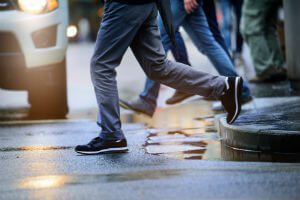 In Ontario, drivers are expected to be vigilant about pedestrians and keep a lookout for possible hazards. Therefore, if an accident with a pedestrian occurs, there is a presumption that the accident was caused by the driver. However, there are important exceptions that can shift the blame.
In Ontario, drivers are expected to be vigilant about pedestrians and keep a lookout for possible hazards. Therefore, if an accident with a pedestrian occurs, there is a presumption that the accident was caused by the driver. However, there are important exceptions that can shift the blame.
If you were injured in a pedestrian accident, a Windsor car accident lawyer from our firm may be able to help. Let us review your situation and your eligibility for compensation during a free consultation.
Driving Laws for Pedestrian Safety
There are several driving laws that concern pedestrians, including the following:
- Drivers must yield the whole roadway at pedestrian crossovers, school crossings and other locations where a crossing guard is present
- Drivers must stop their vehicles when a pedestrian is in a designated crossover or crossing zone and cannot proceed until the pedestrian is off the roadway
- Drivers must not pass a vehicle stopped at a pedestrian crossover
- Drivers must not pass a moving vehicle located within 30 metres of a crossover
Do Pedestrians Have the Right of Way?
Pedestrians do not always have the right of way. Sometimes drivers have the right of way while pedestrians have the right of way in other situations. Drivers and pedestrians must obey the laws.
Pedestrians can cross the street at traffic lights at designated crosswalks. They should only walk when the light indicates that it is safe to do so. Pedestrians cannot begin crossing the street during the countdown. Drivers must yield to pedestrians who are crossing the street while the walk signal or countdown is activated.
Where there are no traffic lights, pedestrian crossovers may be available to help pedestrians safely cross the roadway. Drivers must use common sense at these points to avoid collisions. Pedestrians should not step into a crossover when an approaching vehicle is nearby.
Pedestrians are required to apply proper judgment when crossing on a marked or unmarked crosswalk.
Even though the pedestrian may be violating right of way rules, the driver must still be vigilant about looking out for possible dangers. In a pedestrian accident, it is usually on the driver to show that the other party is at fault.
Fault in Pedestrian-Related Accidents
Before any damages will be paid to either party involved in a pedestrian accident, fault must be determined. Motorists have a duty to exercise due care to protect the safety of others. A driver who hits a pedestrian may be presumed negligent, in which case the pedestrian only needs to prove that the collision occurred and he or she suffered an injury.
Liability is sometimes split between the parties if the motorist can show that the pedestrian acted in a careless manner.
Damages Available to Injured Pedestrians
Pedestrians who are hit by a car often suffer serious and catastrophic injuries due to the lack of protection surrounding them and the weight and power of a vehicle. An injured pedestrian has the same rights as others involved in a car accident and may be able to make a claim against the at-fault driver’s insurance company for the damages that they suffered.
These damages may be significant and may include:
- Medical expenses
- Future care costs
- Loss of income
- Loss of earning capacity
- Pain and suffering
- Loss of enjoyment of life
If your injuries are considered catastrophic in nature, you may be eligible to up to $1 million more in damages for medical rehabilitation and attendant care benefits.
Request a Free Consultation
Pedestrian accidents often cause serious, life-changing injuries. If you were involved in a pedestrian accident, the legal team at Greg Monforton and Partners is prepared to fight for your best interests.
We work on a contingency-fee basis, so we charge nothing up front for our services unless we recover compensation for you. We are available anytime, 24/7.
Call(866) 320-4770 today to schedule your free consultation.

